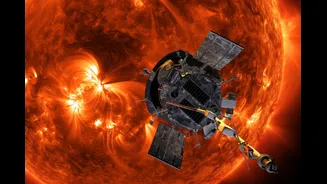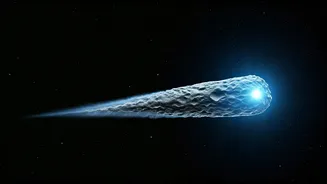Astronomers around the world are keeping a close watch on a mysterious interstellar object named 3I/ATLAS, which has left experts scratching their heads. The object has suddenly sped up, changed colour,
and even lost its tail, all without a clear reason.
Discovered in July by a telescope in Chile, 3I/ATLAS is only the third-known visitor from outside our solar system, after ‘Oumuamua and Borisov. NASA has confirmed that it poses no threat to Earth. The comet will make its closest approach to our planet in December, passing about 269 million kilometres away.
By late October, the comet looked brighter and had turned a noticeable shade of blue as it moved closer to the Sun. Its speed also increased to around 2,44,600 kmph, showing a small but mysterious “kick” that scientists say can’t be explained by gravity alone.
Experts Try To Decode The Mystery
NASA’s navigation engineer, Davide Farnocchia, said the comet seems to be experiencing “non-gravitational acceleration,” meaning something other than gravity is pushing it forward.
Harvard astrophysicist Avi Loeb believes the extra push is caused by gas and dust escaping from the comet. “As it expels this material at a greater rate, it is being kicked in the opposite direction,” he explained in a blog post. Loeb estimated that the comet could lose about a tenth of its mass in just one month.
In another interview, Loeb mentioned that observations from Chile’s ALMA telescope showed a slight but statistically significant deviation in the comet’s path. He repeatedly said this could be due to the evaporation of a large part of its mass.
Loeb added that if the comet is indeed losing so much material, it should soon appear surrounded by a giant gas plume as it moves through space in November and December.
Scientists Notice Strange Colour Shift
Another big surprise came when astronomers noticed that 3I/ATLAS had changed colour, turning bluer as it neared the Sun.
Some reports suggested it had changed colours multiple times, but astronomer Qicheng Zhang from the Lowell Observatory said that’s not true. “We don’t have any evidence for the gas coma changing colours,” he told Space.com. “The comet just appeared blue once when its gas coma became visible, and it’s stayed that way, only brighter.”
Zhang said that by early September, amateur astronomers had already captured images showing its blue-green glow, caused by sunlight reacting with gases released from the surface.
Harvard astrophysicist Loeb, known for his bold theories, said the colour might have another explanation. “The non-gravitational acceleration might be the technological signature of an internal engine,” he reportedly suggested, adding that the blue hue could come from an artificial light source or heat. Still, he said the natural explanation, ionised carbon monoxide, is more likely.
Comet’s Tail Vanishes Unexpectedly
In the latest images, astronomers were stunned to find that 3I/ATLAS has no tail. Normally, comets form bright, glowing tails when heated by the Sun. This one, however, seems to have lost it completely.
Loeb said that nearly 13 per cent of its mass should have formed a tail, but none is visible. NASA and the European Space Agency plan to keep tracking the comet as it heads toward Jupiter in March 2026.
How 3I/ATLAS Got Its Name
The comet was named after the ATLAS (Asteroid Terrestrial-impact Last Alert System) survey team in Chile that first spotted it on July 1. The letter “I” stands for “interstellar,” and the number “3” means it is the third object from outside our solar system ever detected.














